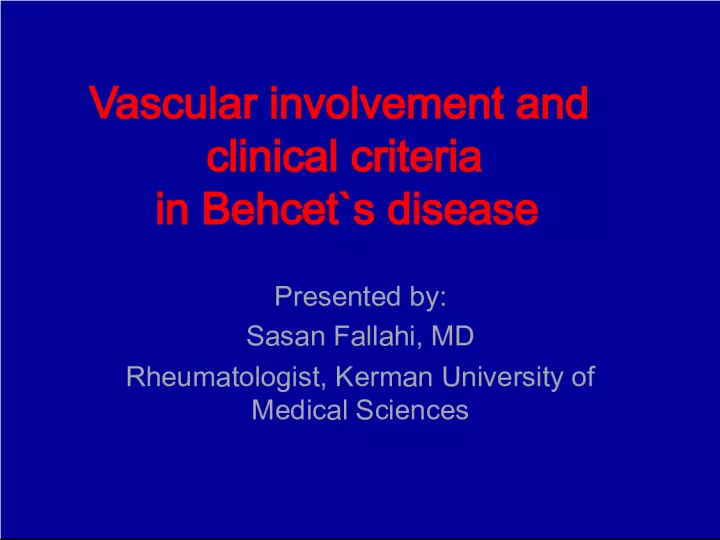"Vascular Involvement and Clinical Criteria in Behcet's Disease: A Presentation by Sasan Fallahi, MD"


In this presentation, Rheumatologist Sasan Fallahi discusses the history, epidemiology, and clinical
- Uploaded on | 0 Views
-
 gerryjacobs
gerryjacobs
About "Vascular Involvement and Clinical Criteria in Behcet's Disease: A Presentation by Sasan Fallahi, MD"
PowerPoint presentation about '"Vascular Involvement and Clinical Criteria in Behcet's Disease: A Presentation by Sasan Fallahi, MD"'. This presentation describes the topic on In this presentation, Rheumatologist Sasan Fallahi discusses the history, epidemiology, and clinical. The key topics included in this slideshow are . Download this presentation absolutely free.
Presentation Transcript
Slide1Vascular involvement andclinical criteria in Behcet`s disease Presented by: Sasan Fallahi, MD Rheumatologist, Kerman University of Medical Sciences
Slide2History• First description: Hippocrates in 5 th century before BC • First modern: Hulusi Behcet in 1937 (a case with recurrent oral aphtous, genital aphtous, uveitis)
Slide3Epidemiology• worldwide • Most prevalent in silk road ( middle east, Mediterranean,…) • Turkey: 80-370 in 100000 • Iran: 80 in 100000 • Japan: 13.6, China: 14 in 100000 • Spain: 7.5 in 100000 • Uncommon in northern Europe & USA (0.1-7.5 in 100000)
Slide5Clinical manifestations• Major: * mucosal * Skin * eye • Minor: * joint, CNS, GI, vascular,…
Slide6Vascular disorders• Iran: 8.3%, Turkey: 17%, ITR-ICBD: 18% • Any size • Venous: more common *superficial phlebitis, DVT, large vein thrombosis SVC, IVC, supra-hepatic, portal vein thrombosis cerebral venous and retina thrombosis • Arterial: *aneurism, thrombosis
Slide7Pathophysiology of vasculitis and thrombosisAntigen Antigen (HSP) (HSP) Antigen Antigen (HSP) (HSP) Genetic background B51 Super Ag Macrophage (APC) T cell ( ɣ δ ) IL1 TNF α , β , INF ɣ B cell AECA Vessel wall t hrombosis PMN CAM, IL8 Superoxide, NO Tissue Hyperhomocysteinemia, antiphospholipid Ab, decrease protein C, S, antithrombin ΙΙΙ Factor V Leiden mutation
Slide8Pathogenesis of aneurisms• Unclear • Suggested: Exogenous Exogenous factor factor Exogenous Exogenous factor factor Genetic background Mononuclear cells Mononuclear cells Mononuclear cells Mononuclear cells Functional impairment Functional impairment Functional impairment Functional impairment Obliterative endarteritis of vasa vasorum, endothelial cell swelling, perivascular infiltration Obliterative endarteritis of vasa vasorum, endothelial cell swelling, perivascular infiltration Obliterative endarteritis of vasa vasorum, endothelial cell swelling, perivascular infiltration Obliterative endarteritis of vasa vasorum, endothelial cell swelling, perivascular infiltration Destruction of media, arterial wall thickening Destruction of media, arterial wall thickening Destruction of media, arterial wall thickening Destruction of media, arterial wall thickening Aneurysm formation Aneurysm formation Aneurysm formation Aneurysm formation
Slide9Superficial thrombophlebitis• Most frequent type • May predict visceral involvement • Increase risk of DVT • Main symptom: localized extremity pain • May occur after venipuncture • Females are affected more than males
Slide10DVT• Males > females • More common in younger age of disease onset • Reported as an initial symptom • Critical period for development: 2-3.2 years after diagnosis of Behcet disease • Tend to occur earlier than arterial involvement
Slide11IVC thrombosis• 15% of large vessel involvement • Should be suspected in: * alternating venous thrombosis in lower limbs * Recurrent venous thrombosis in one limb
Slide12Budd-Chiari syndrome• Characterized by hepatomegaly, RUQ pain, ascites, oedema of lower limbs • Rarely, spontaneous remission • Mostly, at risk of slowly progressive hepatic failure, • Not common
Slide13SVC thrombosis• 1.4-9.8% of venous involvement • Blockage of lymphatic circulation: chylothorax
Slide14Cerebral venous thrombosis• Main symptom: persistent headache and papilledema due to intracranial HTN, may be the presenting feature of disease • Is not rare
Slide15Peripheral artery involvement• Marked male predominance • Any peripheral artery: femoral, popliteal, iliac and abdominal aorta • Infrequent in carotid artery • Venous involvement is found in most patients • Occlusion is more common than aneurysm but both is not unusual finding • Clinical presentation: asymptomatic to pulsatile mass, back pain, painful mass, hematoma, intermittent claudication, abdominal pain, gangrene of forefoot, … • Rate of death: up to 60%
Slide16Pulmonary vascular involvement• The most sever: Pulmonary artery aneurism: leading cause of death • Almost exclusively in males • Most frequent symptom: chest pain, hemoptysis • Association with: DVT of lower limbs, vena cava or intra-cardiac thrombosis and aneurysms in other sites
Slide18LaboratoryESR, CRP (ESR in Iran: 40% normal) HLA B5: 53% in Iran HLA B51: 47% in Iran, ITR-ICBD: 49% Pathergy: 54% in Iran, ITR-ICBD: 49%
Slide19Diagnosis & diagnostic criteria• Clinical • Diagnosis criteria: -Curth, 1946 -Mason & barnes, 1969 -O Duffy: 1974 -Dilsen: 1986 -japan: 1972, 1988 -ISG: 1990 -Iran: 1993 - international criteria (ITR-ICBD) (2006) - new ICBD (2010)
Slide20Sensitivity: 91%, specificity:96%ISG criteria (1990)
Slide21Iran criteria(1993) • Oral aphthae 1 • Skin lesions (PF, EN) 1 • Pathergy test 1 • Genital aphthae 2 • Eye lesions 2 >= 3 score indicates Behcet disease
Slide22ITR-ICBD( International Team for the Revision of the International Criteria for Behcet’s Disease) • Participants: 27 countries – Austria, Azerbaijan, China, Egypt, France, Germany, Greece, India, Iran, Iraq, Israel, Italy, Japan, Jordan, Libya, Morocco, Pakistan, Portugal, Russia, Saudi Arabia, Singapore, Spain, Taiwan, Thailand, Tunisia, Turkey, USA • Data Collection: March 2005 to June 2006 • BD patients: 2556
Slide23international criteria (ICBD)Oral aphthosis 1 Skin lesions (PF, EN) 1 Vascular lesions 1 Pathergy test 1 Genital aphthosis 2 Eye lesions 2 3 or more points » Behcet’s Disease ( sensitivity: 96%, specificity: 88%, accuracy: 93.8%)
Slide24New international criteria (new ICBD)• Oral aphthae 2 • Skin lesions (PF, EN) 1 • Vascular lesions 1 • Genital aphthae 2 • Eye lesions 2 • CNS lesions 1 • Pathergy test 1 (some where) >= 4 score: sensitivity: 94%, specificity: 90.5% (International society for Behcet disease, 8-10 July 2010, London)
Slide25•Vascular * arterial thrombosis : cytotoxic + prednisolon * DVT : cytotoxic + prednisolon * superficial phlebitis : NSAID * large vessel thrombosis : anticoagulant + cytotoxic + prednisolon * Peripheral arterial aneurysm : arterioplasty + corticosteroid + cytotoxic * Pulmonary arterial aneurysm: corticosteroid + cytotoxic ± embolization or surgery (in life threatening haemoptysis) Treatment
Slide26Morbidity:• most common: ocular blindness Mortality: • Low • Related to pulmonary, CNS, bowel perforation